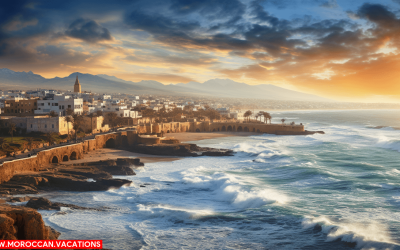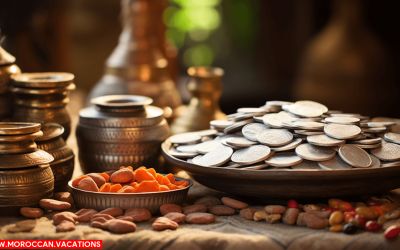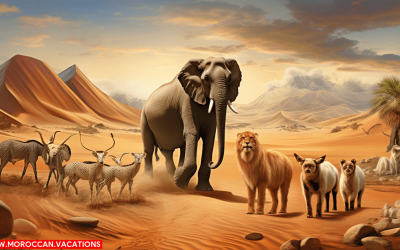Which Languages Are Spoken in Morocco?
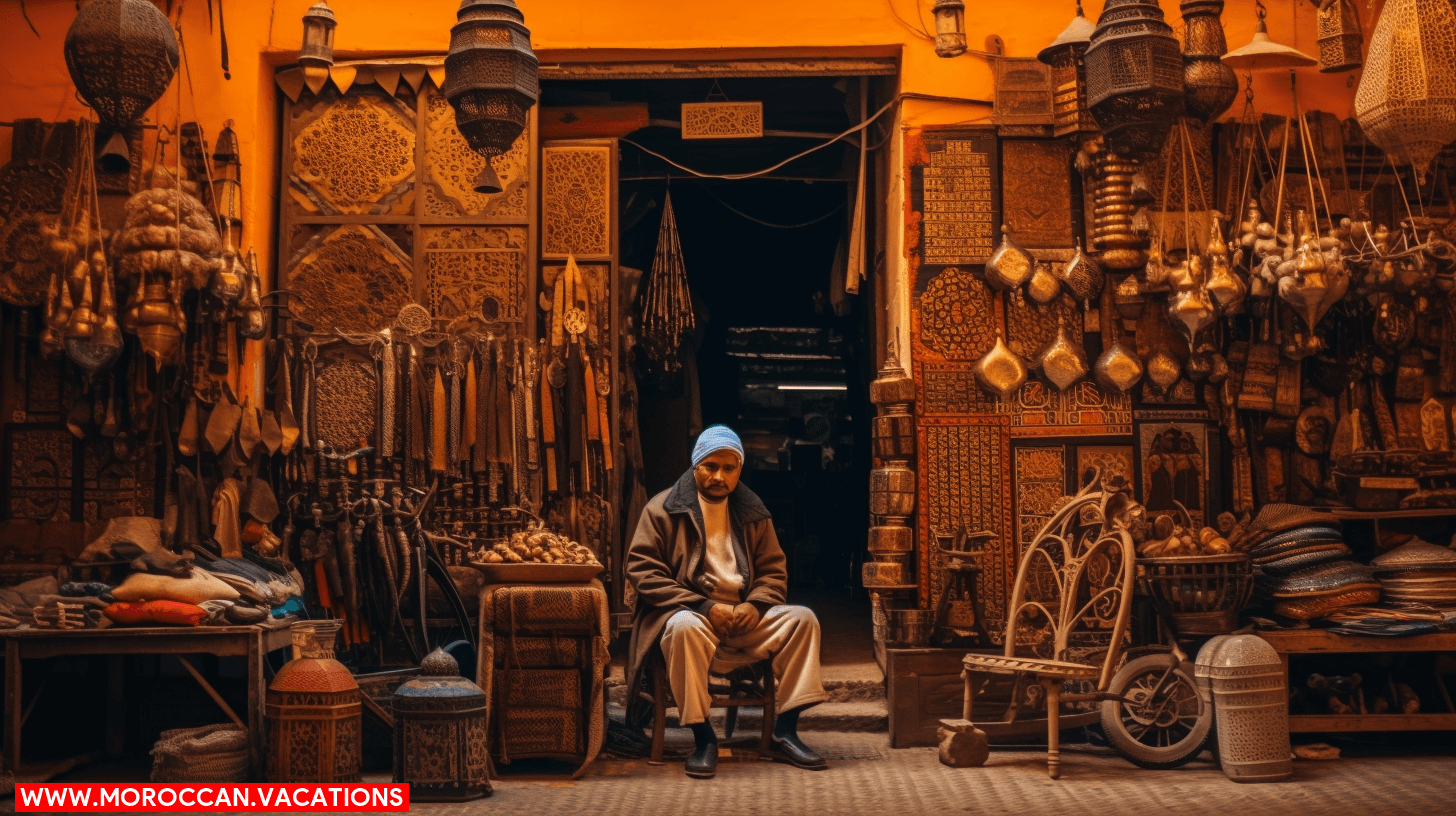

In the colorful tapestry of Moroccan culture, you’ll discover that the locals don’t limit themselves to just one mode of conversation. What Language Do They Speak in Morocco? At the heart of Morocco’s linguistic landscape, you’ll find Arabic, specifically Moroccan Arabic, or Darija, which serves as the country’s vernacular. It’s the language you’ll hear in the markets, the streets, and echoing from the minarets. Yet, the soul of Morocco’s heritage is also captured in the Berber languages, mainly Tamazight, which has gained official status, reflecting the nation’s strides toward inclusivity. French, a remnant of colonial times, still plays a significant role in business and education, offering a gateway to international discourse. As you navigate through Morocco’s medinas and mountains, you’re engaging with a society that values the freedom expressed through a rich blend of languages.
You’ll find that Morocco’s linguistic landscape is as diverse as its culture, with multiple languages spoken across the country. The official languages, Arabic and Amazigh, serve as the bedrock of Morocco’s linguistic identity, while a myriad of indigenous dialects reflect the country’s complex social fabric. Additionally, the prevalence of foreign languages, including French, Spanish, and increasingly English, underscores Morocco’s historical ties and evolving global connections.
Official Languages Speak in Morocco
In Morocco, you’ll find that Arabic and Amazigh (Berber) are the country’s official languages, spoken widely throughout the kingdom. The commitment to indigenous language preservation is reflected in the promotion of Amazigh, evidencing the broader multilingualism in Morocco. Language policies in Morocco have evolved to recognize the linguistic diversity in North Africa, with a particular focus on ensuring that language and education in Morocco are intertwined, fostering an environment where cultural heritage is seamlessly integrated into learning.
The Arabic dialects in Morocco vary considerably, yet Modern Standard Arabic remains a cornerstone in formal settings. This linguistic tapestry, woven into the fabric of Moroccan society, underscores the importance of language in maintaining and celebrating the nation’s rich cultural identity.
Indigenous Languages in Morocco
Beyond Arabic and Amazigh, you’ll encounter several other indigenous languages peppered across Morocco’s diverse landscape. These regional dialects are not merely means of communication but embody the cultural significance of indigenous languages tied to language and ethnic identity. Engaging with traditional language practices, you become privy to the rich tapestry of human expression unique to each community.
Indigenous language preservation in Morocco is not a relic of the past but a dynamic field marked by linguistic diversity initiatives. Language revitalization efforts are pivotal in maintaining the vibrancy of these tongues. Such strides toward safeguarding these linguistic treasures reflect an understanding that the freedom of a people is anchored in the ability to cherish and express their heritage through the most intimate medium known: their mother tongue.
Foreign Languages Spoken in Morocco
How about exploring the foreign languages you can encounter while traversing the vibrant streets of Morocco? Beyond the indigenous languages’ importance, the French and Spanish influence looms large, a testament to historical ties. French, in particular, serves as a lingua franca, often a prerequisite for professional success, while Spanish’s prevalence echoes in the northern regions, harkening back to colonial times.
European languages usage isn’t merely a practicality; it’s a cultural diversity reflection, mirroring Morocco’s multifaceted identity. Language preservation efforts are crucial in maintaining a balance between honoring local tongues and embracing global communication.
Multiculturalism and linguistic diversity significantly impact social interactions, enriching dialogue, and fostering an environment where freedom of expression thrives amidst a tapestry of voices.
North African and European Languages in Morocco
As you navigate Morocco’s rich linguistic landscape, you’ll encounter a blend of North African and European languages, reflecting centuries of cultural exchanges and historical influences. The tapestry of languages spoken in Morocco underscores a multicultural society deeply rooted in its linguistic heritage. Here’s how this manifests:
- North African Languages:
- Arabic: Predominant and official; Classical version in formal settings.
- Amazigh (Berber): Indigenous with several dialects; Tifinagh script for writing.
- Language Preservation: Active efforts to maintain Amazigh through education and media.
- European Influence:
- French: Widely used in business, education, and diplomacy.
- Spanish: Spoken in the northern regions, legacy of past proximity.
- Language Diversity: Reflects historical interactions between Morocco and European powers.
- Cultural Significance:
- Bilingualism: Common among Moroccans, symbolizing open-mindedness and adaptability.
- Linguistic Identity: Represents the country’s pluralistic essence, with each language contributing to the collective narrative.
Is Arabic the Main Language Spoken in Morocco?
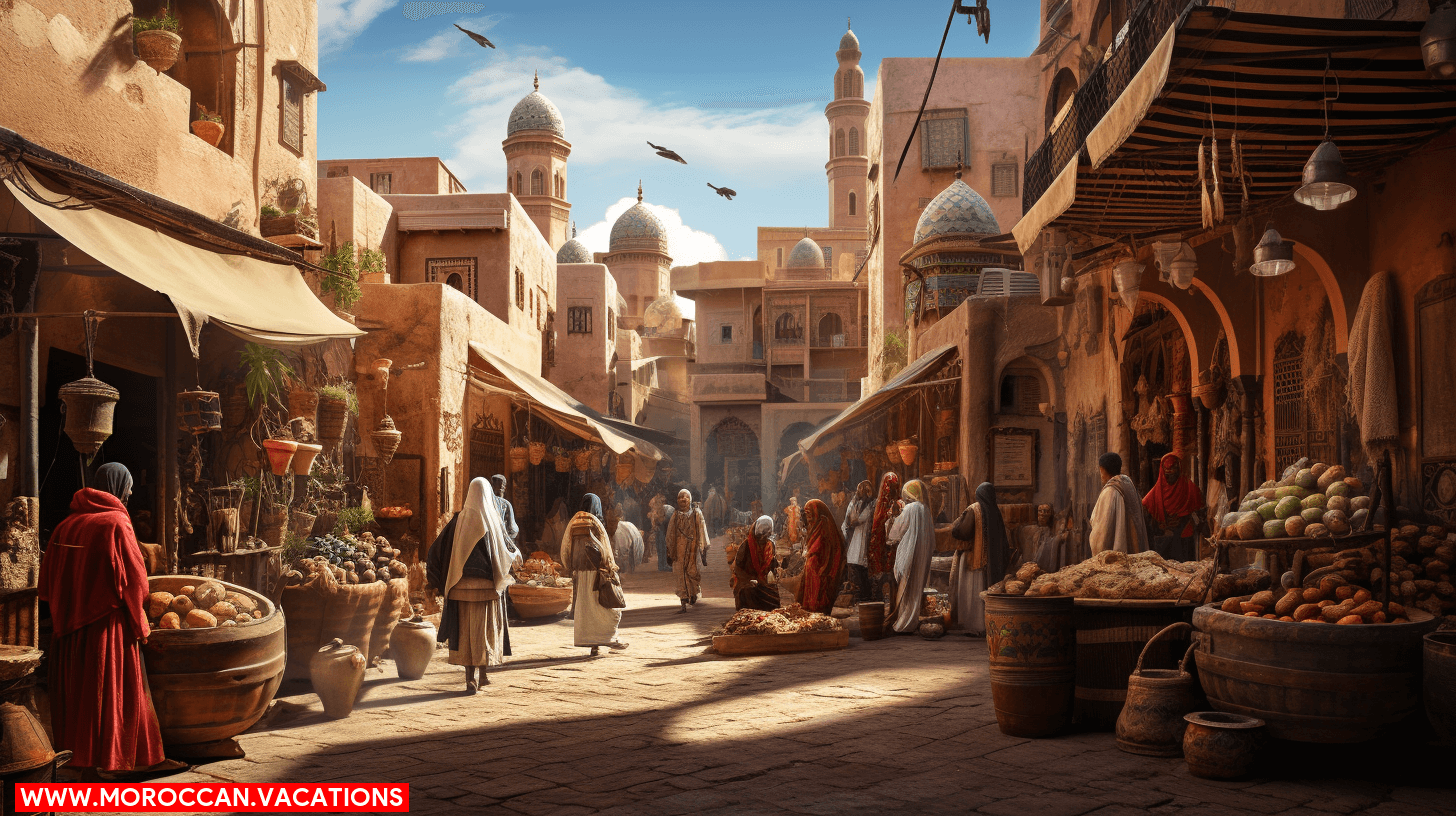

You may wonder if Arabic holds the primary linguistic position in Morocco’s sociocultural landscape. Indeed, Moroccan arabic, known locally as Darija, serves as the predominant dialect, intimately woven into the daily communication of most Moroccans. Meanwhile, Modern Standard Arabic has its established domain within the nation’s educational system and media, reflecting a layered linguistic identity.
Varieties of Arabic Spoken in Morocco
In Morocco, the primary language you’ll encounter is Moroccan Arabic, also known as Darija, which exhibits a unique blend of Arabic dialects infused with Berber, French, and Spanish influences. Analyzing the linguistic landscape reveals:
- Varieties of Moroccan Arabic:
- Urban vs. rural dialects
- Regional variations with distinct phonetic characteristics
- Influence of French language:
- Vocabulary enrichment
- Code-switching prevalence in education and business
- Significance of Berber languages:
- Recognition as a national language reflecting Morocco’s indigenous heritage
- Efforts to preserve Berber languages through official education and media
These elements underscore the role of language in Moroccan cultural identities and the impact of language on social interactions, illustrating the country’s complex linguistic mosaic and its people’s quest for cultural freedom.
Moroccan Arabic as the Primary Dialect
When exploring Morocco, you’ll primarily hear Moroccan Arabic, the country’s predominant dialect. This unique form of Arabic, rich in its varieties, embodies the linguistic landscape in Morocco, weaving through the medinas and echoing in the Atlas Mountains. The language policy in Morocco recognizes it, although Modern Standard Arabic and Amazigh are official.
| Aspect | Moroccan Arabic | Impact |
| Policy | Informally prevalent | Guides language acquisition |
| Barriers | Diverse dialects | May challenge communication |
| Tourism | Accessible with basics | Enhances visitor experience |
Analytically, language barriers in Morocco arise from these dialects, influencing language acquisition and necessitating language preservation efforts. For you, the freedom-seeker, understanding this dialect is crucial to immerse in the culture, particularly when language and tourism in Morocco are intertwined.
Modern Standard Arabic in Education and Media
While Moroccan Arabic dominates daily conversations, it’s Modern Standard Arabic that’s primarily used in education and media across Morocco. The state’s language policy in education mandates the use of Modern Standard Arabic, fostering a linguistic environment where Arabic serves as a lingua franca, bridging the diverse varieties of Moroccan Arabic.
- Language Policy in Education:
- Centralized curriculum
- Bilingualism with French in higher education
- Efforts to preserve Amazigh languages
Media representation of Moroccan Arabic often takes a backseat to Modern Standard Arabic, reflecting language attitudes that value linguistic unity and intellectualism. Yet, a language shift in urban areas and the quest for freedom in social expression are nurturing bilingualism and subtly transforming Moroccan society, indicating a potential redefinition of language use in both public and private spheres.
Arabic as a Second Language in Morocco
Although you might assume that everyone in Morocco speaks Arabic as their first language, many Moroccans actually learn Modern Standard Arabic as a second language. This phenomenon is deeply intertwined with the nation’s intricate language policy, which strives for language preservation while acknowledging language diversity. The Arabic dialects spoken at home often diverge significantly from the standardized form taught in schools, necessitating a deliberate process of language acquisition.
Language and identity in Morocco are therefore complexly layered, with Modern Standard Arabic serving as a unifier in public life and media. Nonetheless, language revitalization efforts, particularly for indigenous Amazigh languages, highlight the dynamic nature of linguistic expression in Morocco, simultaneously embracing tradition and the freedom of linguistic evolution.
What is the Significance of Berber Languages in Morocco?
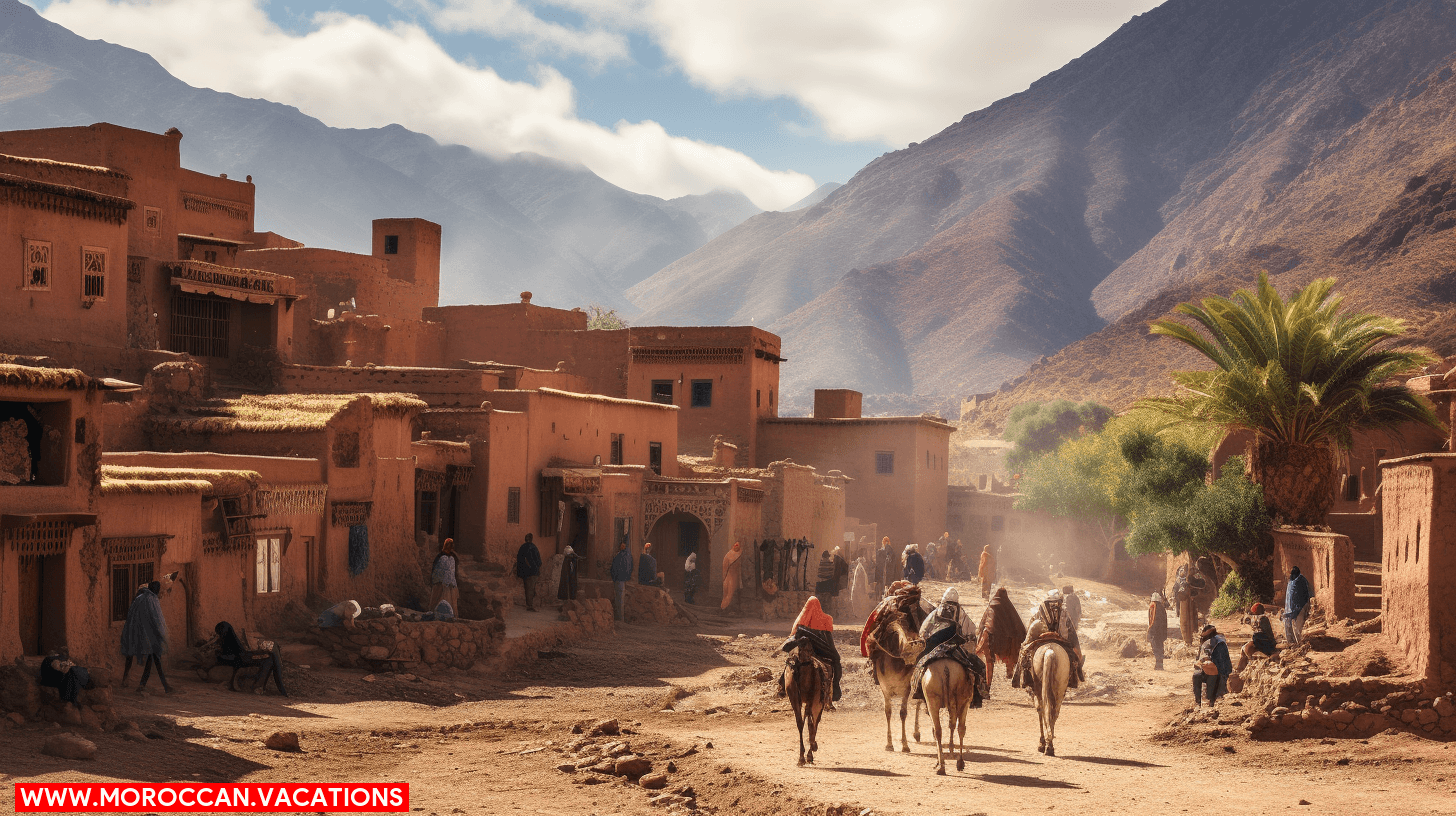

You must understand that the Berber languages in Morocco aren’t merely communication tools; they’re the sinews of a rich historical and cultural tapestry. Their distribution across the country highlights the regional identities and influences that shape Morocco’s societal mosaic. Initiatives to preserve and promote these languages are not just about saving dialects but about maintaining the integral elements of Moroccan heritage and identity.
Historical and Cultural Importance of Berber Languages
Berber languages, integral to Morocco’s heritage, carry the whispers of ancient North African civilizations and remain a vibrant part of the nation’s cultural mosaic. These tongues are not only a means of daily communication but also a repository of the nation’s soul, encapsulating its identity and heritage. Consider the multifaceted roles they play:
- Geographical distribution & preservation efforts
- Spanning across rural and urban divides
- Initiatives to document and revitalize languages
- Educational programs fostering linguistic diversity
- Cultural influence & social interactions
- Shaping norms and values
- Facilitating unique forms of community engagement
- Influencing social dynamics
- Artistic expression & identity
- Inspiring literature, music, and art
- Expressing collective memory and individual experiences
- Cementing a sense of belonging
Your understanding of Morocco’s essence is incomplete without recognizing the profound significance of Berber languages.
Geographical Distribution of Berber Languages in Morocco
In exploring Morocco’s linguistic landscape, you’ll find that the Berber languages are intricately woven across its varied regions, from remote mountain villages to bustling city streets. These indigenous languages, an essential strand in the fabric of North African languages, have a geographical distribution that underscores their cultural importance. Berber dialects thrive amid the nation’s linguistic diversity, coexisting with Arabic and foreign languages like French and Spanish. The presence of Berber tongues throughout Morocco is a testimony to the resilience of these ancient languages, which continue to shape identities and experiences. Despite the dominance of global tongues, Berber dialects retain significance, offering you a glimpse into a Morocco that fiercely preserves its linguistic heritage while engaging with the modern world.
Efforts to Preserve and Promote Berber Languages
Amid the linguistic tapestry of Morocco, your understanding deepens as we examine the efforts to preserve and promote Berber languages, reflecting their profound significance in Moroccan society. These endeavors underscore a commitment to cultural identity and linguistic diversity, essential for a society valuing freedom and self-expression.
- Efforts to Revitalize:
- Berber Language Revival: Implementation of language revitalization programs.
- Education and Promotion: Introduction of Berber languages in educational curricula.
- Cultural Significance: Reinforcement of Berber identity through media and cultural events.
Language preservation initiatives are not mere academic exercises; they’re a lifeline to a rich heritage. The Berber language revival isn’t just about words; it’s about sustaining the soul of a community, ensuring that the unique threads of Morocco’s identity continue to enrich the global cultural fabric.
Berber Dialects and Their Influence in Moroccan Culture
You’ll discover that the three primary Berber dialects—Tamazight, Tashelhit, and Tarifit—play a pivotal role in shaping Morocco’s cultural landscape. These tongues are not mere communication tools; they carry the weight of a rich berber language heritage, embodying the nation’s diverse soul. The cultural significance of Berber is evident in music, literature, and daily life, ensuring berber languages influence persists in contemporary society. Language revival efforts are crucial for preserving this linguistic diversity in Morocco, with activists and scholars striving to safeguard these dialects against the tides of globalization. Berber dialects preservation is more than an academic pursuit; it’s a fight for cultural identity, ensuring that the echoes of ancient voices continue to enrich the fabric of Moroccan life.
What Other Languages Are Spoken in Morocco?
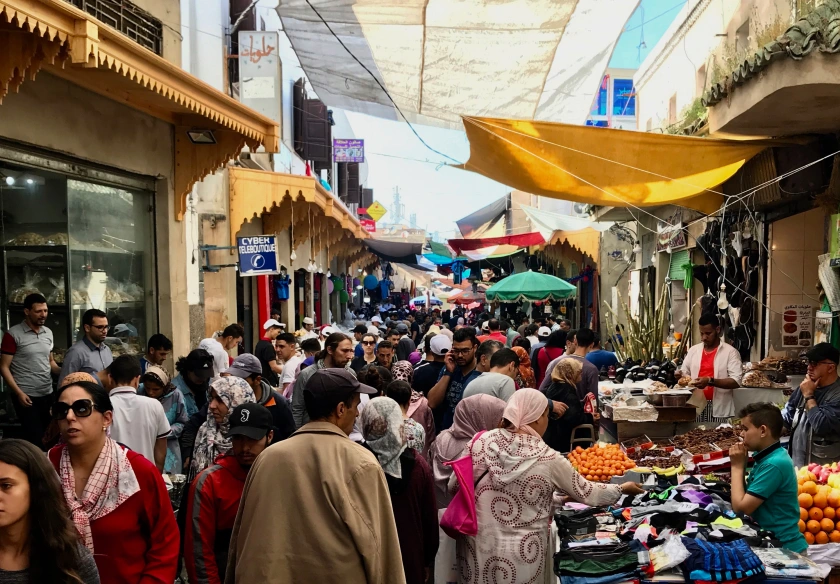

Photo by: @https://tonemanblog.com/2018/08/19/rabat-moroccos-capital-city/
You might be surprised to learn that Morocco’s linguistic landscape extends well beyond Arabic and Berber tongues. The historical influence of colonial powers has firmly entrenched both French and Spanish in various facets of Moroccan society, with French often serving as a lingua franca in business and education, while pockets of Spanish influence persist, notably in the northern regions. Moreover, the prevalence of European languages and their interplay with indigenous expressions underpin the complex matrix of Moroccan cultural identities.
Influence of French and Spanish Languages in Morocco
Languages such as French and Spanish have significantly shaped Morocco’s linguistic landscape, reflecting the country’s historical ties to Europe. The influence of colonial languages is evident in:
- Language Policies in Morocco:
- Implementation of bilingual education systems.
- Official recognition of French in legislative and diplomatic affairs.
- Language and Social Integration in Morocco:
- French as a lingua franca among different ethnic groups.
- Spanish influence in northern regions, facilitating cross-cultural communication.
- Language and Business in Morocco:
- Necessity of French for professional opportunities.
- Spanish as a vital asset in trade with Spain.
The interplay between language and identity in Morocco, alongside the role of language in education, tourism, and business, underscores the profound impact these European languages have on Moroccan society.
European Languages and Their Usage in Moroccan Society
Understanding the prevalence of European languages in Moroccan society requires a look beyond French and Spanish to consider other languages that enrich the country’s diverse linguistic tapestry. Your exploration of language education in Morocco may reveal that, while French and Spanish hold significant sway, the study of languages like English and German is increasingly emphasized. This shift mirrors global economic trends and the nation’s strategic language policy in Morocco, aiming to expand trade and diplomatic relations.
| European Languages | Impact in Morocco |
| English | Language and economy in Morocco; preferred in business and technology |
| German | Growing importance due to trade and investment links |
| Italian | Recognized in tourism and business sectors |
| Portuguese | Limited but relevant in historical and cultural contexts |
| Dutch | Niche but noteworthy within the expatriate community |
Language barriers in Morocco, however, can impede social mobility and access to opportunities, necessitating inclusive language policy reforms. Language and politics in Morocco are intertwined, with linguistic choices often reflecting deeper socio-political currents.
Indigenous Languages Beyond Arabic and Berber
While you’ll primarily hear Arabic and Berber spoken throughout Morocco, there are other indigenous tongues that retain a presence in certain communities. These languages are not just means of communication; they’re vessels of cultural significance and embody the essence of Morocco’s rich heritage.
- Indigenous Language Preservation
- Efforts to document and teach minority languages to younger generations.
- Impact of such preservation on cultural identity and heritage.
- Linguistic Diversity’s Influence
- Linguistic influence on Moroccan cuisine; recipes and terms passed through generations.
- Traditional practices influenced by languages, enriching Morocco’s cultural tapestry.
- Cultural Expressions through Language
- Language revitalization efforts contributing to a diverse cultural landscape.
- The impact of language on Moroccan music, showcasing linguistic diversity in artistic forms.
You’ll find that these efforts reflect a societal yearning for freedom—a freedom to maintain and celebrate one’s linguistic heritage.
The Role of Language in Moroccan Cultural Identities
In exploring Morocco’s cultural identities, you’ll discover that languages such as Spanish, French, and various Amazigh dialects play crucial roles beyond Arabic. The interweaving of languages in Morocco is not merely a means of communication but a vibrant tapestry reflecting the nation’s diverse heritage.
| Aspect of Culture | Language Influence | Examples |
| Cuisine | French, Arabic | French terms in haute cuisine, Arabic in street food |
| Music | Amazigh, Arabic | Lyrics in traditional songs, preserving heritage |
| Architecture | Arabic, French | Arabic inscriptions, French colonial influence |
Language serves as a cornerstone in Moroccan cuisine, music, fashion, architecture, customs, oral storytelling, and religious practices, shaping the nation’s identity and expressing freedom through cultural diversification and preservation.
How Does Language Reflect the Cultural Diversity of Morocco?
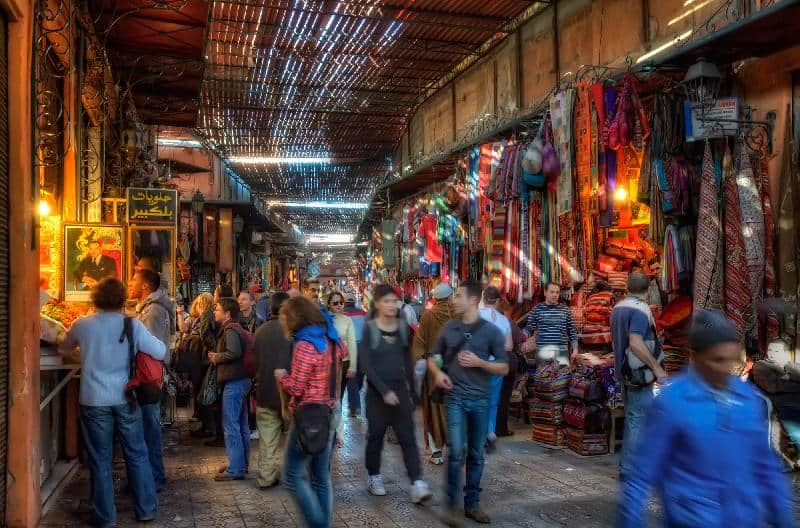

Photo by: @https://www.canadiantraveller.com/Morocco_Three_Magical_Marketplaces
You’ll find that Morocco’s tapestry of languages, from Arabic and Amazigh to French and Spanish, is a vibrant reflection of its multicultural lineage. This linguistic mosaic not only shapes social interactions and traditions but also deeply infiltrates the realms of Moroccan art and literature. The complex interplay between language and identity within the nation’s heritage offers profound insights into the Moroccan ethos.
Multiculturalism and Linguistic Diversity in Moroccan Society
Morocco’s myriad languages mirror its rich cultural tapestry, with each dialect and tongue revealing a unique facet of the nation’s diverse heritage. The landscape of multilingualism in Moroccan society is a testament to its cultural plurality.
- Language and identity in Moroccan society:
- Berber languages reinforce indigenous identities.
- Arabic and French serve as vectors of pan-Arab and Western influences.
- Language policies in Morocco and their impact:
- Official recognition of Amazigh languages reflects cultural inclusivity.
- Language and education in Morocco are intertwined, with curricula incorporating multiple languages to foster unity and comprehension.
- The economic and sociocultural dimensions:
- Language and economic development in Morocco are linked; multilingualism attracts foreign investment and tourism.
- Language and social integration in Morocco, alongside language and cultural preservation, are crucial for a harmonious, progressive society.
Impact of Language on Social Interactions and Traditions
Commonly, you’ll find that language profoundly shapes social interactions and traditions, reflecting the cultural mosaic that is Morocco. The impact of language on social interactions is palpable in the bustling souks and tranquil mosques, where communication cements community ties and perpetuates age-old customs. Language preservation efforts are crucial in maintaining the linguistic diversity in Moroccan society, ensuring that languages like Tamazight continue to express cultural identities and enrich the national heritage. This diversity is a testament to Morocco’s multicultural ethos, where language is not just a tool for conversation but a vessel for the collective memory. Language in Moroccan art and literature serves as both a canvas and a bridge, uniting varied ethnic narratives and showcasing the pluralistic nature of Moroccan life.
Linguistic Expression of Moroccan Art and Literature
Delving into Moroccan art and literature, you’ll discover a tapestry of linguistic richness that mirrors the country’s cultural diversity. As you explore:
- Linguistic Diversity
- Artistic expression in Morocco is a vibrant fusion, from Berber motifs to Arabic calligraphy.
- Literary traditions stretch across Arabic, French, and Spanish influences, each adding depth to the narratives.
- Language Preservation
- Indigenous languages like Tamazight find voice in both oral and written form, safeguarding cultural significance.
- Efforts to document and promote these languages are vital to maintaining language and identity.
- Cultural Significance
- Through poetry, storytelling, and visual arts, language embodies the Moroccan spirit.
- The interplay of languages in Morocco’s creativity reflects a society cherishing freedom and multiplicity.
Language and Identity in the Context of Moroccan Heritage
As you delve deeper into Morocco’s heritage, you’ll notice how language weaves into the very fabric of its cultural identity, reflecting a society rich in diversity and history. Language preservation and revitalization in Morocco aren’t merely academic pursuits; they’re pivotal to maintaining the nation’s mosaic of traditions. Language policies, therefore, play a crucial role in both safeguarding linguistic heritage and fostering language and education systems that embrace this multiplicity. The interplay between language and identity formation in Morocco is profound. It’s through multilingual fluency that Moroccans navigate their complex social tapestry, enabling language and social integration. Moreover, understanding and utilizing the linguistic assets of Morocco serve as a backbone for language and economic development, aligning with a vision of progress that honors cultural plurality.
Introducing Ayoub Karbachi, a brilliant wordsmith and curator of the Moroccan Vacations website. Prepare to immerse yourself in mesmerizing narratives and extraordinary moments, as he unveils the allure of Morocco's captivating destinations like never before.
Related Articles
What Is the Capital of Morocco? Unveiling the Geographical Marvel of North Africa.
Where Is the Capital of Morocco Located? You might be thinking, "Why should I care about the capital of Morocco?" Well, let's uncover the fascinating city of Rabat, the capital of Morocco, and its unique charm in North Africa. Get ready to explore the geographical...
What Is the Currency in Morocco?
Discover the current currency in Morocco with our comprehensive guide. Uncover essential information about Moroccan currency, exchange rates, and practical tips for managing your finances in this North African destination. Plan your trip with confidence and stay informed about the monetary landscape in Morocco.
What Animals Live in the Sahara Desert
Types of Animals Found in the Sahara Desert Photo by: @https://owlcation.com/stem/sahara-desert-animals Imagine yourself tracking the majestic dromedary camel across the vast, sandy dunes of the Sahara Desert. As you embrace the spirit of adventure, you're not alone...

